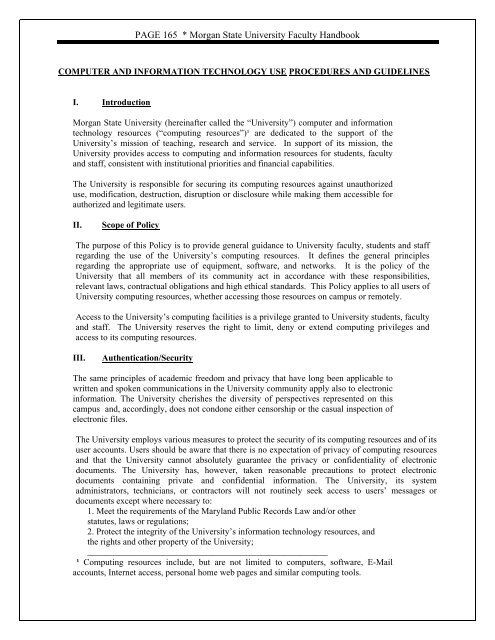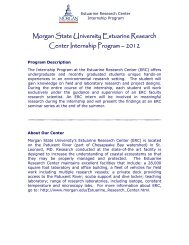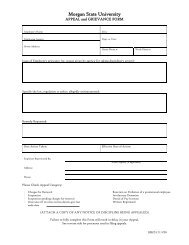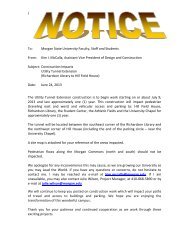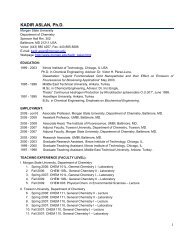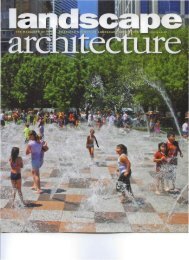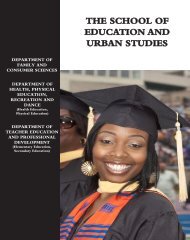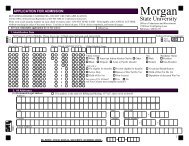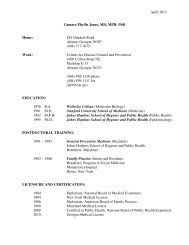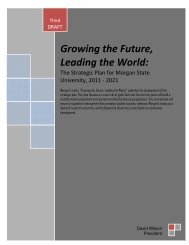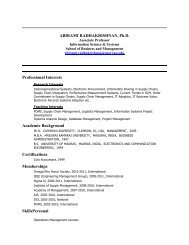FACULTY HANDBOOK July 2009 - Morgan State University
FACULTY HANDBOOK July 2009 - Morgan State University
FACULTY HANDBOOK July 2009 - Morgan State University
You also want an ePaper? Increase the reach of your titles
YUMPU automatically turns print PDFs into web optimized ePapers that Google loves.
PAGE 165 * <strong>Morgan</strong> <strong>State</strong> <strong>University</strong> Faculty HandbookCOMPUTER AND INFORMATION TECHNOLOGY USE PROCEDURES AND GUIDELINESI. Introduction<strong>Morgan</strong> <strong>State</strong> <strong>University</strong> (hereinafter called the “<strong>University</strong>”) computer and informationtechnology resources (“computing resources”)¹ are dedicated to the support of the<strong>University</strong>’s mission of teaching, research and service. In support of its mission, the<strong>University</strong> provides access to computing and information resources for students, facultyand staff, consistent with institutional priorities and financial capabilities.The <strong>University</strong> is responsible for securing its computing resources against unauthorizeduse, modification, destruction, disruption or disclosure while making them accessible forauthorized and legitimate users.II.Scope of PolicyThe purpose of this Policy is to provide general guidance to <strong>University</strong> faculty, students and staffregarding the use of the <strong>University</strong>’s computing resources. It defines the general principlesregarding the appropriate use of equipment, software, and networks. It is the policy of the<strong>University</strong> that all members of its community act in accordance with these responsibilities,relevant laws, contractual obligations and high ethical standards. This Policy applies to all users of<strong>University</strong> computing resources, whether accessing those resources on campus or remotely.Access to the <strong>University</strong>’s computing facilities is a privilege granted to <strong>University</strong> students, facultyand staff. The <strong>University</strong> reserves the right to limit, deny or extend computing privileges andaccess to its computing resources.III.Authentication/SecurityThe same principles of academic freedom and privacy that have long been applicable towritten and spoken communications in the <strong>University</strong> community apply also to electronicinformation. The <strong>University</strong> cherishes the diversity of perspectives represented on thiscampus and, accordingly, does not condone either censorship or the casual inspection ofelectronic files.The <strong>University</strong> employs various measures to protect the security of its computing resources and of itsuser accounts. Users should be aware that there is no expectation of privacy of computing resourcesand that the <strong>University</strong> cannot absolutely guarantee the privacy or confidentiality of electronicdocuments. The <strong>University</strong> has, however, taken reasonable precautions to protect electronicdocuments containing private and confidential information. The <strong>University</strong>, its systemadministrators, technicians, or contractors will not routinely seek access to users’ messages ordocuments except where necessary to:1. Meet the requirements of the Maryland Public Records Law and/or otherstatutes, laws or regulations;2. Protect the integrity of the <strong>University</strong>’s information technology resources, andthe rights and other property of the <strong>University</strong>;______________________________________________________¹ Computing resources include, but are not limited to computers, software, E-Mailaccounts, Internet access, personal home web pages and similar computing tools.


